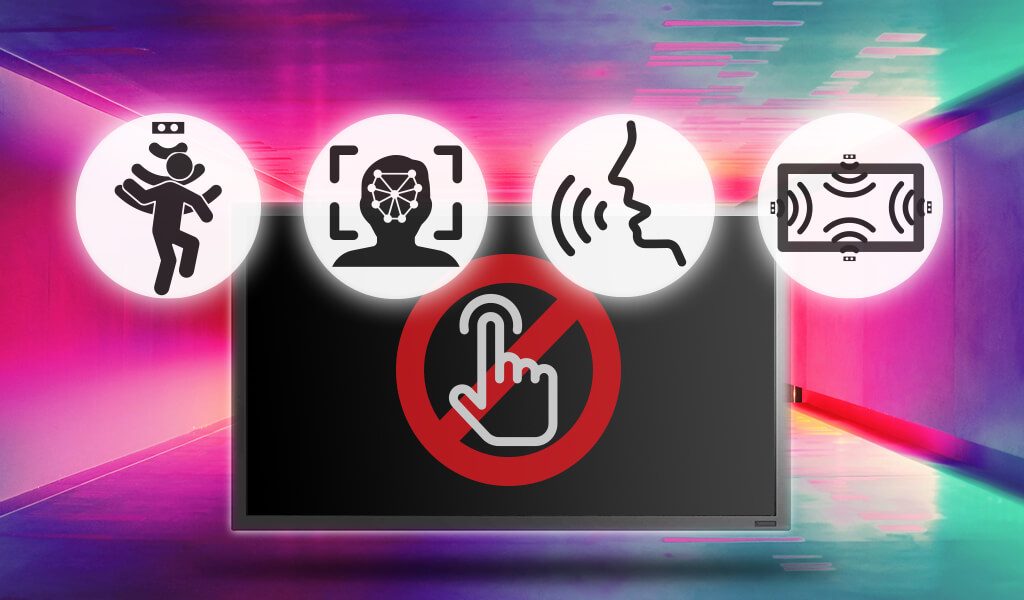
Touchless interaction: redefining customer engagement in Digital Signage
Touchscreens have long been a popular technology to enhance customer engagement in retail experiences. However, this year has seen a shift, with traditional touchscreens temporarily giving way to new, forward-thinking interaction methods that are shaping the future of Digital Signage.
When touch technology was first introduced to Digital Signage, users had to adjust to this novel way of interacting. It wasn’t an instant success; it took time for people to naturally and intuitively adopt the habit of using touch to request information, navigate spaces, or provide feedback. Eventually, however, interacting with screens became second nature.
Then came 2020—a year that required adaptability on a global scale, pushing interactive technologies to find new, contact-free solutions. In response, the Digital Signage industry began exploring the potential of touchless technology.
Touchless technologies are an ideal fit for today’s Digital Signage systems, as they can be easily integrated. Most setups require only the addition of cameras, proximity sensors, or microphones to existing screens, allowing for a smooth transition to touchless functionality without the need for a full network overhaul.
Touchless Touchscreen: gestures and voice as inputs
Touchless technology enables interaction through gestures or voice commands rather than physical contact. Its purpose is to let customers engage with screens and kiosks safely, without touching potentially contaminated surfaces—a growing concern in recent times.
There are four primary types of touchless interaction technologies currently used as alternatives to traditional touchscreens:
- Motion Detection
- Optical Pattern Recognition
- Screen Pointing
- Voice Recognition
1. Motion Detection
Motion detection technology identifies shifts in an object’s position relative to its surroundings, typically tracking the user’s hand or face. Combined with proximity sensors, motion detection records interactions whenever movement disrupts its visual field. When this occurs, the software interprets the interaction and responds according to recognized movement patterns, displaying the desired content.
For example, a virtual catalog might allow customers to flip pages by moving their hand near the screen—no physical touch required. The sensors detect and interpret the gesture, turning the page as requested.
2. Optical pattern recognition
Before diving into optical pattern recognition, let’s briefly explain what “patterns” mean here. In psychology, patterns are familiar structures that allow us to recognize daily situations. They help our brain respond to familiar visual cues, such as recognizing a face or understanding speech. Optical pattern recognition works similarly. A camera on the screen identifies familiar shapes or patterns and reacts by displaying relevant content without physical contact.
For instance, in an eyewear store, a screen’s camera might detect a customer’s facial structure, relay the information to the software, and then display the ideal eyewear options for that individual.
3. Screen pointing
Screen pointing lets users select icons and elements on a screen without physically touching it. Sensors and cameras detect hand movements to determine what the user wants to achieve.
For example, if there is a call-to-action (CTA) button in the lower-right corner of the screen, a hand movement detected in that area triggers the information request form without the user needing to tap the screen.
4. Voice recognition
Voice recognition is already widely used on smartphones and home devices. From Google Home and Alexa to Siri, this technology is familiar to most. Voice recognition can also replace touch to create a fully touchless experience, allowing customers to interact with screens hands-free. Voice control enables a nearly limitless range of interactions, all without any physical contact.

Although voice recognition is currently the most common form of touchless interaction, other methods are expected to grow significantly in popularity in the coming years. Given the need for alternatives, touchless technology is likely to be adopted more quickly than touchscreens were originally. The necessity of new interaction methods in today’s unique environment has accelerated this shift.
When the pandemic becomes a memory, touchless experiences won’t fade away. Instead, the birth of a new customer experience via motion detection and voice recognition was bound to happen eventually; 2020 simply accelerated its arrival.
